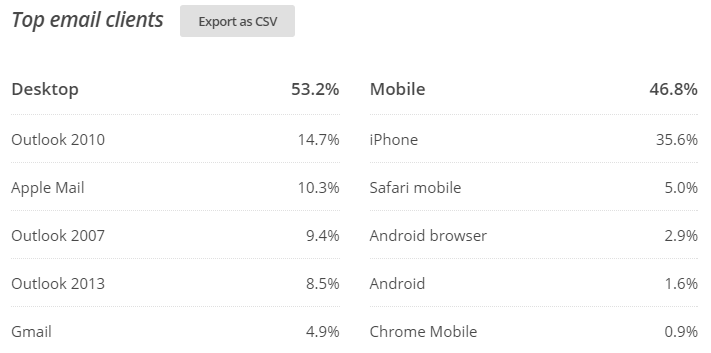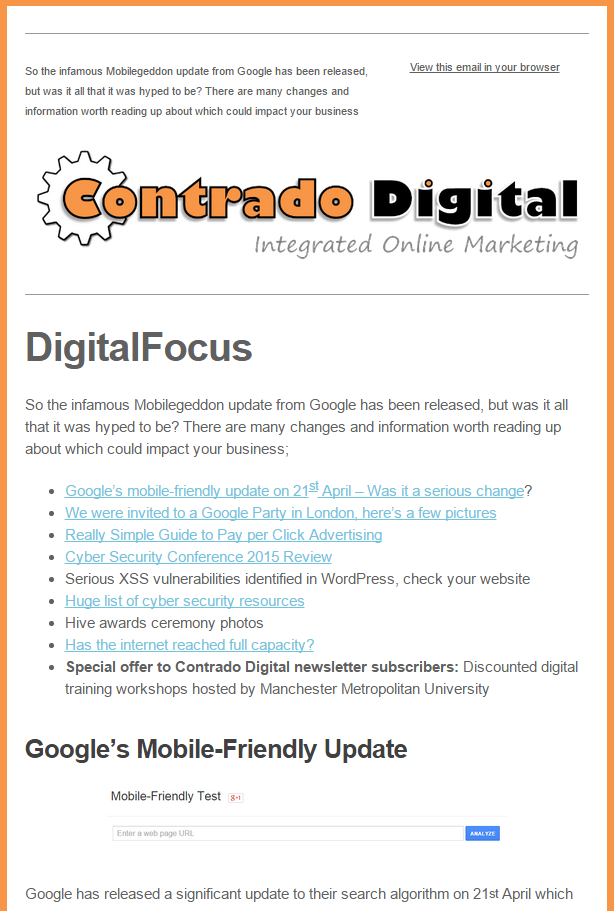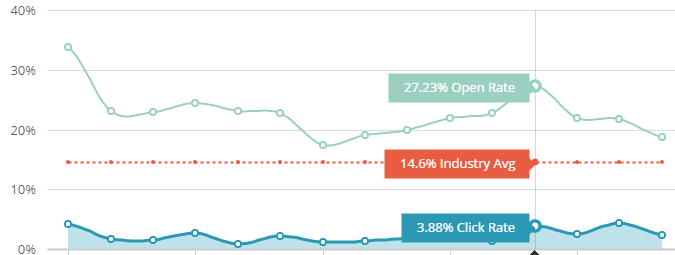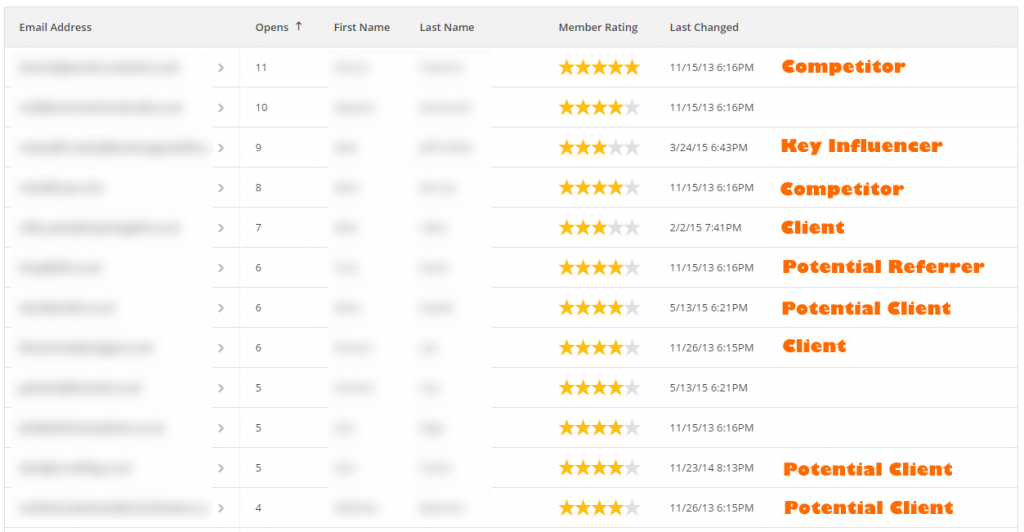Really Simple Guide to Email Marketing
Keeping your customers informed about the products and services they are interested inEmail marketing is an extremely powerful way to keep your customers and potential customers up to date with the products, services and information they are interested in. Being able to communicate with a group of people who are interested in your products or services can be a very effective way to increase revenue.
This Really Simple Guide to Email Marketing is designed to give you an overview of the benefits your business can experience from running successful email marketing campaigns. Most businesses aren’t effectively using email marketing campaigns and all of the features available.
What Not to Do
Let’s start with the basics here. We naturally speak with a lot of businesses about email marketing on a daily basis and we hear a lot of stories of what is currently happening within businesses. Stories which make us cringe a little when we hear about them as they are so ineffective we couldn’t even imagine someone actually spending an awful lot of time doing ineffective things.
For example, many businesses start off with the concept of email marketing by using Outlook (or similar) to send out bulk emails to a list of email addresses to their customers. Sending out emails manually through an email system is always limited to a certain number of people who can be BCC’d into the email which means that this method is extremely time consuming, generally a maximum of 50 people per email. As an extreme example, we recently helped one company who were using this method to send emails out to their database of 22 million customers. Not a very efficient use of time I’m sure you’ll agree! Systems like this always results in someone slipping up and CC’ing people into the email rather than BCC’ing them into the email, meaning that everyone can see everyone else’s email addresses which is a clear breach of data protection and is extremely unprofessional. You also cannot personalise the email such as “To…{First Name}” which again isn’t very personal or professional.
We also see companies buying bulk email lists online from various sources and simply spamming these people with promotional messages and special offers. Please, stop doing this. Not only will this lead to you getting blacklisted as a spammer, it is also not a very professional way to promote your products or services. If you happen to be using an email marketing platform while using this approach, then it is highly likely that they will kick you off their service for spamming. This includes if you are a member of the Chamber of Commerce and happen to receive an email list for all of the members, email marketing platforms and the people receiving the emails would prefer not to be spammed without consent.
There is a better way and that is to use a reputable email marketing platform.
What is Email Marketing
Before we jump in and look at email marketing platforms specifically, let’s just clarify what exactly email marketing is and why you should be doing it. Email marketing allows you to communicate with all of your current customers and potential customers who have opted-in to your email marketing list with ease. Simply write a single email within an email marketing platform of your choice and an email will be personalised and sent to every individual on your email list. This is fully customisable based on many different factors such as the person’s details, their previous behaviour on the email list such as if they have or haven’t opened previous emails, or even based on their behaviour on your website which can be extremely useful for ecommerce websites which we will cover a little later.

Email Marketing Software
There is an endless list of email marketing software available for you to assess as can be seen with just a small selection of the most common platforms available listed below;
- MailChimp
- Constant Contact
- Vertical Response
- GetResponse
- Campaign Monitor
- Yesware
- iContact
- Aweber
- Jango Mail
- Active Campaign
- Benchmark
- Astonish Email
- Emma
- MPZMail
- MailerLite
- Salesforce Marketing Cloud
- Mailigen
- MailUp
- Freshmail
- DirectIQ
- Zoho
- DotMailer
- Bronto
Before you can make a decision on what email marketing platform is best suited to yourself though, you need to start with what you are looking to achieve from the email marketing platform.
Email Marketing Goals
What are you aiming to achieve from your email marketing campaigns and how are they integrated as part of your overall digital marketing strategy? Simply running an email marketing campaign in isolation is not going to work. Your customers don’t live in a single touchpoint with your brand, so let’s join the dots together to provide your email subscribers a rich experience. Here are a few ideas for what your email marketing goals could be;
- Simply to keep customers updated about what you are doing as a business and what is happening in the industry you are working in
- To provide educational content for your subscribers to help with their daily work
- To inform potential customers about key regulatory changes they need to be aware of
- To invite people to an event you are running in the local area
- To send out promotional offers and discount codes to entice customers to purchase more frequently
- To send out targeted email campaigns based on previous purchase history and increase revenue
- To send out shopping cart abandonment emails to increase conversion rates and revenue – i.e. send your customers an email when they add something to your ecommerce basket and leave the website without completing their purchase
- To send out emails to customers based on the products and pages they view on your ecommerce website and encourage them to purchase key products in the future
There are many reasons why you would run an email marketing campaign, and you may be running your email marketing campaigns for all of the reasons above. Although it is most likely that you will have quite a narrow focus which will help you to tailor the content you send out.

Once you know what you are trying to achieve from your email marketing campaigns you can tailor the content and frequency of your emails which can work towards these goals. One point to note is that you may want to think carefully about how your customers will perceive your emails. For example, many businesses focus solely on promotional email campaigns with “another 5% off…” or “limited time only…” or “buy today and save…”. While this approach can work in the short term to increase revenue, longer term this can significantly damage the brand as customers will just remember you for offering discounts at all times, meaning that many customers will simply prefer to wait for the next offer until they re-order again, rather than ordering at full price. Again, this depends on what you are trying to achieve, since you may be absolutely happy with this and in certain price sensitive industries this can be an effective method to keeping customers engaged.
Email Marketing Campaigns
Before we look at what type of content to include in your email marketing campaigns and how frequently to send campaigns, first let’s look at the underlying technology. Just as with a website, it is essential that your email template is fully responsive, meaning that it will display correctly on mobile devices. To put this into perspective, data from our own email marketing campaigns shows that almost 50% of subscribers opening emails are using a mobile device of some sort;

If we didn’t have a responsive email template, we would be annoying over half of our subscribers who would simply unsubscribe as they would find the content difficult to read. Don’t make this common mistake and assume that people read emails on their laptops only. An interesting point here is that the people subscribed to our email marketing list are clearly businesses focused based on the type of work that we do. The number of mobile users will vary hugely per industry, so keep a close eye on how your campaigns are accessed once you start your email marketing campaigns running.
Email Marketing Campaigns Content
So what exactly do you write in your newsletters? Well this all depends on your initial goals as each of the goals outlined above will require significantly different content based on what users are expecting. For example, you can see one of our recent email marketing newsletters that was sent out here;

For ourselves, we tend to include a summary of what has happened in the industry recently that people need to be aware of, summary information about what we have been blogging about that businesses need to be aware of along with any other information that is useful for people to know. As we are a service based business, this requires a significantly different approach than what would work for an ecommerce website.
As a comparison, for ecommerce websites there are a lot of different emails that can be sent out to customers which are aiming to achieve different outcomes;
- “People who ordered X also ordered Y” type emails: Could be sent automatically to customers after 7 days of their purchase of item X
- “Here’s 10% off items on your next order if you order within 30 days”: Can be particularly useful if you know the average ordering time between orders is 40 days, you can generate an extra few purchases per customer throughout the year which can soon stack up
- “Your items are still waiting in your shopping basket, here’s 5% off”: Can help to entice people to complete their checkout if they have added items to their basket but left the website without completing the purchase.
The type of content in your email marketing campaigns can be varied and in more sophisticated campaigns you will only be sending out emails to a sub-set of your customers based on specific criteria. For many businesses though, let’s look at getting the basics right before we move onto the more interesting things you can do with email marketing.
How Often to Send Email Marketing Campaigns
This is a common question we get asked and the real answer is “it depends” and it does. It depends hugely based on who is on your email marketing list, how engage they currently are (i.e. are they opening emails and clicking on links, or are they simply deleting emails straight away without even opening them?) and more.
Clearly sending an email every day to your email list is going to annoy people, unless of course you have daily specials such as supermarket discount prices or a Groupon type setup whereby people are actively expecting daily discounts and deals to arrive in their inbox. Knowing your audience and what they would expect helps you to tailor the frequency of your emails based on what is most likely to work best. You can test these assumptions with data in the future once you’ve set up your campaign and have some data to analyse. For now though, try and put yourself in the shoes of your customers.
Generally speaking, for a lot of businesses simply sending a group broadcast email once per month is sufficient. Many organisations send weekly emails to customers which clearly does work. But they will have tested this approach to make sure that they aren’t losing more subscribers than they are gaining. Sending emails too frequently can result in subscribers clicking that dreaded “unsubscribe” button and you have lost them forever. As a good rule of thumb, just be nice and don’t harass your email subscribers.
Tracking your Email Marketing Campaigns
Tracking, as always, is hugely important and is the only way you are going to know how well your email marketing campaigns are performing. Thankfully all reputable email marketing platforms come with a range of tools to track the performance of your campaigns which allows you to track information.
Overall statistics per campaign
- Open rate: How many people opened your emails that you sent
- Click through rate: How many people clicked on links in your email
- Industry average comparisons
- Performance of campaigns over time

This overall campaign performance data is extremely useful as it allows you to benchmark your email marketing campaigns against each other over time and also against industry averages. Looking at the data above, it is clear that our campaigns specifically are performing well at way above the average industry standard. Campaigns open rates fluctuate naturally based on the time of day campaigns are sent out, the title of your email and even the day of the week can impact performance of your campaigns. Understanding this data allows you to make an informed decision about what is working and what isn’t working. Most importantly, keep on testing to improve the performance of your campaigns over time.
Individual Statistics per Subscriber
Overall aggregated data is valuable and can often be enough to look at for many businesses. For ourselves though, being a business-to-business organisation, this means that we need to be keeping the right people happy and engaged with our emails. Analysing this data is extremely valuable as it also highlights how active competitors are keeping an eye on what you are doing, clearly for inspiration of their own 😉

It’s interesting to see that certain competitors are always at the top of the list of those reading our emails which is nice to see. Clearly we’re not just helping current clients and potential clients with their digital marketing campaigns, we’re also giving our competitors a few ideas about how the digital world is working.
Data is great, but it is what you do with it that counts. We’ve talked with businesses using this data in some quite interesting ways in the past, with sales staff using this data (in a business-to-business environment) to call engaged subscribers a few days after they have received the email, often resulting in a sale or two in the process. With great power comes great responsibility though. Don’t be creepy. Yes, you can see a lot of data about the people opening your emails, but if you go calling someone within 5 minutes of them opening your email and saying “Hey Bob, I noticed you just opened our email. How are you doing?” – Don’t do that. That would be very creepy.
Google Analytics Data
Going beyond tracking data within your email marketing platform, you can then track all of this data back to enquiries generated or ecommerce sales made on the website. All serious website owners are running Google Analytics which provides a wealth of information about how people are behaving on your website. This information all starts from a single data source, which is where this person came from.
![]()
When you set up tracking correctly within your email marketing platform, you can clearly see within Google Analytics website visitors who viewed your website as a direct result of you sending out an email marketing campaign. Which you can then track to understand what revenue this has generated. This can be extremely valuable for an ecommerce website as when you understand the lifetime value of a customer, you will be surprised at the amount of revenue each customer actually generates. For example;
- For every 100 email subscribers on your email list
- You send out an email every month
- As a direct result of this, 20% of people open the email and 10% of people click on a link, so 10 people actually visit your website
- You have a high performing website which generates an average conversion rate from emails of around 10%. Conversion rates from email marketing campaigns are often high performing for ecommerce websites than other traffic sources such as social media.
- This generates you 1 new sale from a current customer who happens to spend £50 on average
- Assuming you have a profit margin of 50%, you earn £25 profit per order on average
- Based on this, you can calculate that for every 100 email subscribers on your list, you can generate £300 profit per year (£25 profit X 12 months)
- Now in reality, an ecommerce website likely has 10,000’s, 100,000’ or 1,000,000’s of email subscribers, which is continually growing. Scale the numbers above to get an idea of what this would result in additional profit per year, all from sending a few emails.
Now if you were asked the question about how much focus you should put on building your email marketing campaign, what would you say? Is it still one of those activities that isn’t that important? No, it is clearly an extremely powerful marketing activity which can significantly add to the bottom line. As a guideline, data tends to show that email marketing campaigns are only second performing to SEO campaigns in terms of high return on investment levels.
Already started to calculate what this could mean for your business? Get in touch and let’s talk things through further.
Marketing Automation and Autoresponders
All of what we have talked about so far has been related to basic email marketing campaigns, such as sending out emails to all of your subscribers with very little clever automation in place. Now let’s take a look through some of the more exciting things that can be done with email marketing campaigns.
Autoresponders
So an Autoresponder is email marketing on auto-pilot. An Autoresponder allows you to send a series of emails, or a single email, when someone does a specific action on your website. For example, this could be as simple as when someone subscribes to your newsletter and they are sent a welcome email or as complex as subscribing to a series of emails about specific topics. Give it a go yourself, subscribe to our newsletter when this pops up on the screen.
Many, but not all, email marketing platforms have Autoresponder technology within them so it’s always worth checking before you make a decision. A well-crafted Autoresponder can work to build your email marketing list by offering something of real value in return for people giving you their details. This could be as simple as a whitepaper containing some research you have undertaken within a specific industry or something much more in-depth such as a series of training guides that can only be accessed through your mailing list.
Marketing Automation
Marketing Automation generally refers to a more advanced and flexible form of Autoresponder technology. Generally speaking, Marketing Automation technology works best with ecommerce websites. For example, it is possible to automatically send customers emails based on what products they have viewed on the website, or send them special offers if they have added products to their basket online but haven’t completed the purchase.
Taking this to a personal level, it is possible to send customers a special birthday gift such as a special 10% discount on their birthday or similar. By simply setting up an automated rule which runs on a regular basis you can build a strong relationship with your customers through automating key messages.
Building your Email Marketing List
Many digital platforms your business is engaged with are often not under your control, in other words if those platforms were to shut down tomorrow you have lost a significant amount of your audience who is interested in your business, products and services. You email list is different. Capturing data about your customers, specifically their email address, puts you in a powerful position as this is something that you now own. Capturing customer data has been compared to the modern day gold rush and it is easy to see why. Understanding your customers allows you to tailor marketing messages specific to those customers, instead of simply shouting a generic message at everyone which is often ignored.
Building your email list should be an extremely important part of your overall digital marketing strategy as this will work as an additional sales channel without the traditional costs involved with selling. Many statistics are around showing that it is much more profitable to sell more to current customers than to acquire new customers. Email marketing can help with this process significantly.
Before we look at ways to build your email list there are a couple of items to be aware of. People on your email list must have given you permission to be added to the mailing list. In this context, permission means that the person has given consent to receive marketing communications which is verifiable. Depending on who is being added to your mailing list, it can be good to use a double opt-in approach, whereby they have to click a confirmation link in an email after they have registered, which is a clear signal that people are wanting to hear from you. Many businesses select to use a single opt-in approach, whereby once people have subscribed to the newsletter, they do not need to confirm again via email. The reason for this is because you can lose a lot of people as many people will not click the link in the email that is sent to confirm their subscription to the email list.
How to Build your Email List
There are many ways to build your email list which often come down to giving people a reason want to subscribe to your email list. Here are just a few ideas for building your email marketing list;
- Create awesome content on your website: If your content isn’t great, then why would customers want to subscribe to your email marketing list?
- Run a competition: Capturing email addresses from people who have entered a competition can be a great way to build your list.
- Add a link to your employees email signature to subscribe to newsletter: An effective way of building your list can be to inform the people you are naturally communicating with already that you have an exciting email list that they may be interested in.
- Use an on-site popup: Like the one we use, to encourage website visitors to also subscribe to your email marketing list.
- Free whitepaper downloads: Or similar research that will encourage people to download the research to find out information that is useful to them. In return for the whitepaper, people subscribe to the email list.
- Strategic partnerships: To offer valuable content to a strategic partner’s customer list in return for capturing their email addresses.
There are endless ways to build your email list, the above just being a few ideas. Over time as you build your email list you can communicate with more customers and potential customers to grow your revenue.
Improving Performance
Once you are running with your email marketing campaigns, the next step is to improve the performance of the campaigns. With many email marketing platforms it is possible to split test emails to understand more about your audience. This process allows you to test different hypothesis to understand which campaigns are performing best based on the goals from your emails, for example;
- What time of the day is best to send an email to increase revenue?
- What time of day is best to send an email to increase click through rates?
- What subject title works best for an email campaign?
- What day of the week is best to send an email on to increase the open rate?
The benefits of testing the performance allows you to increase the results without needing to grow your email list. Going beyond this, it is possible to segment your email list into specific groups of customers based on different factors.

For example, you could send a message to people who haven’t opened your emails in the last few months with some kind of special offer to re-engage those people. Likewise, you could send an email to customers who regularly click through to the website as they are clearly highly engaged people.
Whatever your business goals are from your email marketing campaigns, you can significantly improve the performance of your campaigns by testing different approaches over time. The world of email marketing is a complex topic with an enormous potential to support your digital marketing strategy and boost your revenue. If you need any support with running your email marketing campaigns effectively, get in touch.
